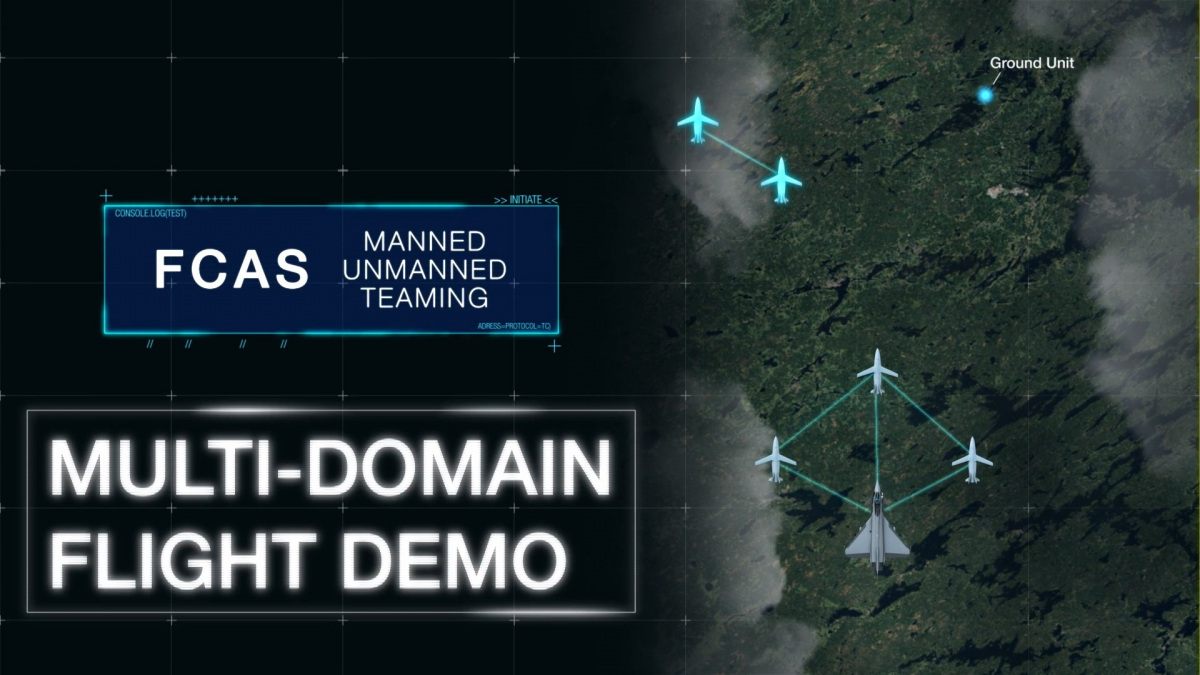This summer, Airbus, for the first time in Europe, demonstrated its new system for controlling drones from an aircraft or helicopter. This demonstration launches phase 3 of the Bundeswehr-funded program, with a future demonstration involving real combat aircraft and helicopters controlling specially developed drones. This capability is expected to be operational by 2030.
A first in Europe
On December 9, Airbus announced in a press release that it had conducted a full-scale test of its Multi-Domain Flight Demo (MDFD) during the summer of 2022. Thus, for the first time in Europe, aircraft, helicopters and drones were interconnected within a realistic scenario: the objective was then to destroy the anti-aircraft defenses of a dummy enemy in order to be able to carry out a special forces helicopter assault to capture the warlord.
This exercise, conducted by Airbus, in cooperation with the Bundeswehr, Finnish Armed Forces, MBDA Deutschland, Patria, startup HAT.tec and Robonic.
A Learjet 35 from GFD (a subcontractor for Airbus) played the role of a mock fighter and a second aircraft flew overhead playing the role of a command aircraft. The mock fighter crew took control of five Do-DT25 drones, connected by the Patria company:
- 2 ESM drones equipped with electronic support sensors (electromagnetic reconnaissance) by MBDA Germany. Their missions were to detect enemy anti-aircraft batteries.
- 3 EO UAVs equipped with electro-optical sensors to record and visually confirm the location of anti-aircraft batteries.
Once the mission of suppressing enemy air defenses (SEAD) was completed, the special forces were helicoptered in. A JTAC, present as part of the assault team, then requested close air support. An H145M helicopter gunship flew to the area. The helicopter connected with one of the three EO drones and flew it to better recognize the tactical situation. The images provided were also available to the ground troops, helping the JTACs to pinpoint the targets to be destroyed. Once the targets were processed by the helicopter, the crew again took control of the EO drone to confirm the destruction.
Toward Phase 3...and beyond?
This demonstration concludes the second phase of the Future Combat Air System Manned-Unmanned Teaming (FCAS MUM-T) program, funded by the Bundeswehr Federal Office for Equipment, Information Technology and In-Service Support (BAAINBw). The third phase will seek to further develop the capabilities demonstrated in this exercise, or even develop new capabilities. The Phase III exercise will no longer include simulated combat aircraft or other test drones, but real operational aircraft and drones actually developed for this purpose.
If the schedule holds, the German Armed Forces should have an operational multi-domain capability by 2030. This will prove critical to the future of the Luftwaffe: current and future drones are all starting to ramp up with artificial intelligence (they no longer need to be directly flown but "just" given orders), but the ability to control them directly by aircraft in flight can become a real force multiplier. This is without forgetting future drones specialized in advanced airborne surveillance, refueling, electronic warfare, electromagnetic reconnaissance or even combat missions.
Two questions remain unanswered, however:
- Will the future German F-35s be able to be upgraded by 2030 with this control capability? Their primary mission being ground attack (with conventional or strategic munitions), the possibility of controlling drones in support could prove to be a real game changer.
- Same idea but in the longer term: could the German NGF or even the entire program concerning the NGF (Germany, France and Spain) be equipped with this system?
Découvrez cet article sur Air&Cosmos

